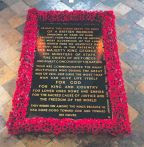 |
| GRAVE OF THE UNKNOWN WARRIOR IN WESTMINSTER ABBEY |
This is the story
of the Unknown Warrior who happened to lie amongst kings and queens in
Westminster Abbey. On the 11 November it will be 91 years since the tomb of the
unknown warrior was established. They decided that they will ot name the grave
of the unknown soldiers because this would again to specify only one section of
the forces. It was decided to create a grave which includes all forces of all
the wars gone and included the First World War. Therefore, the grave of the Unknown
Soldier was named Unknown Warrior. Another suggestion was put forwarded Unknown
Comrade but this was rejected at the time because of the Russian Revolution in
1917 and they adopting the word comrades.
Apparently the Daily Express were the
originators of the suggestion to create a grave for all the people who couldn't
afford to travel to the graves of their fallen loved ones or who had no grave
at all. Another purpose was to establish a grave site to remember forever all
those who fought and lost their lives for Britain.
Selection:
The selection for the tomb of the
Unknown Warrior was as follows:
Six bodies that could not be
identified were taken each from the worst battlefields which were Aisne, the
Somme, Arras and Ypres. These fallen soldiers lay in mass graves with crosses
but no names. They were wrapped and laid in rough coffins. Six Army ambulances
took them to the village St Pol in northern France. The only identification
they had that they were British and died at the beginning of the First World
War. The bodies were unrecognisable.
The coffins were covered with Union
flags. On the 7 November 1920 the soldier stood guard, suddenly stood at
attention and a group of generals entered the hut, at midnight.
Brigadier-General officer commanding British troops in France and Flanders
placed a hand on one of the coffins and with that the Unknown Warrior was chosen.
Not only was the Daily Express
campaigning for it but also an Army chaplain the Rev David Railton. One evening
he passed a small garden and saw a grave marked by a cross. It read: "An
Unknown British Soldier of the Black Watch." The shock made him think who
the man was and how will his family know? From that thought it followed on to
bring an unknown soldier back to Britain as a symbol of all those lost. After
the war Rev Railton wrote to Sir Douglas Haig, Commander of the British forces.
He suggested burying an unknown soldier in Westminster Abbey as a memorial as
well as for families who have no graves to visit.
Since he did not receive even an
answer he contacted the Rt Rev Herbert Ryle, Dean of Westminster Abbey. He was
all for it and contacted King George V and the Prime Minister David Lloyd
George. Ryle added the name 'The tomb of the Unknown Comrade'. It would have
been more appropriate had the Bolshevik not adopted the word
"comrades" and therefore it became known as the Unknown Warrior.
 |
| REV DAVID RAILTON |
Lord Curzon was appointed to oversee
the whole operation. As time was passing by he was strongly advised to have the
ceremony on the 11 November. On the 6 November two undertaker Mr Nodes and Mr
Sourbutts travelled to France. A beautiful oak coffin made from a tree from
Hampton Court was used to place the body in. Two heavy iron straps were topped
by a seal. A simple inscription stated 'A British Warrior Who Fell in The Great
War 1914-1918'. King George V donated a Crusader's sword and it was attached to
the seal.
The coffin was accompanied by six
barrels of earth from France and Flanders. Four soldiers carried the coffin,
the barrels and many wreaths onto the destroyer HMS Verdun. At Dover a white
painted luggage van trapped in purple cloth was pulled by a train moved slowly
towards London. All the way were thousands of people bowing their heads in a
solemn tribute?
At the Victoria Station police had a
great job to control the crowd wanting a closer view. During the night the
coffin was guarded by soldiers and then moved onto a gun carriage. The prossession
was met by the King George V himself at the Cenotaph. He placed his own wreath
onto the coffin. All the way people stood in great silence and their heads
bowed. Apparently only the horses' hooves could be heard.
At 11 o'clock the coffin was carried
through the north transept door of Westminster Abbey. Along the way were 100
Victoria Cross winners standing. The congregation for the service was chosen of
1000 war widows. The sermon lasted one-hour. The coffin was then lowered into a
grave close to the Abbey's main door. The six barrel of earth was poured over
it and a black Belgium marble slab covered the grave and it became the tomb of
the Unknown Warrior.



No comments:
Post a Comment